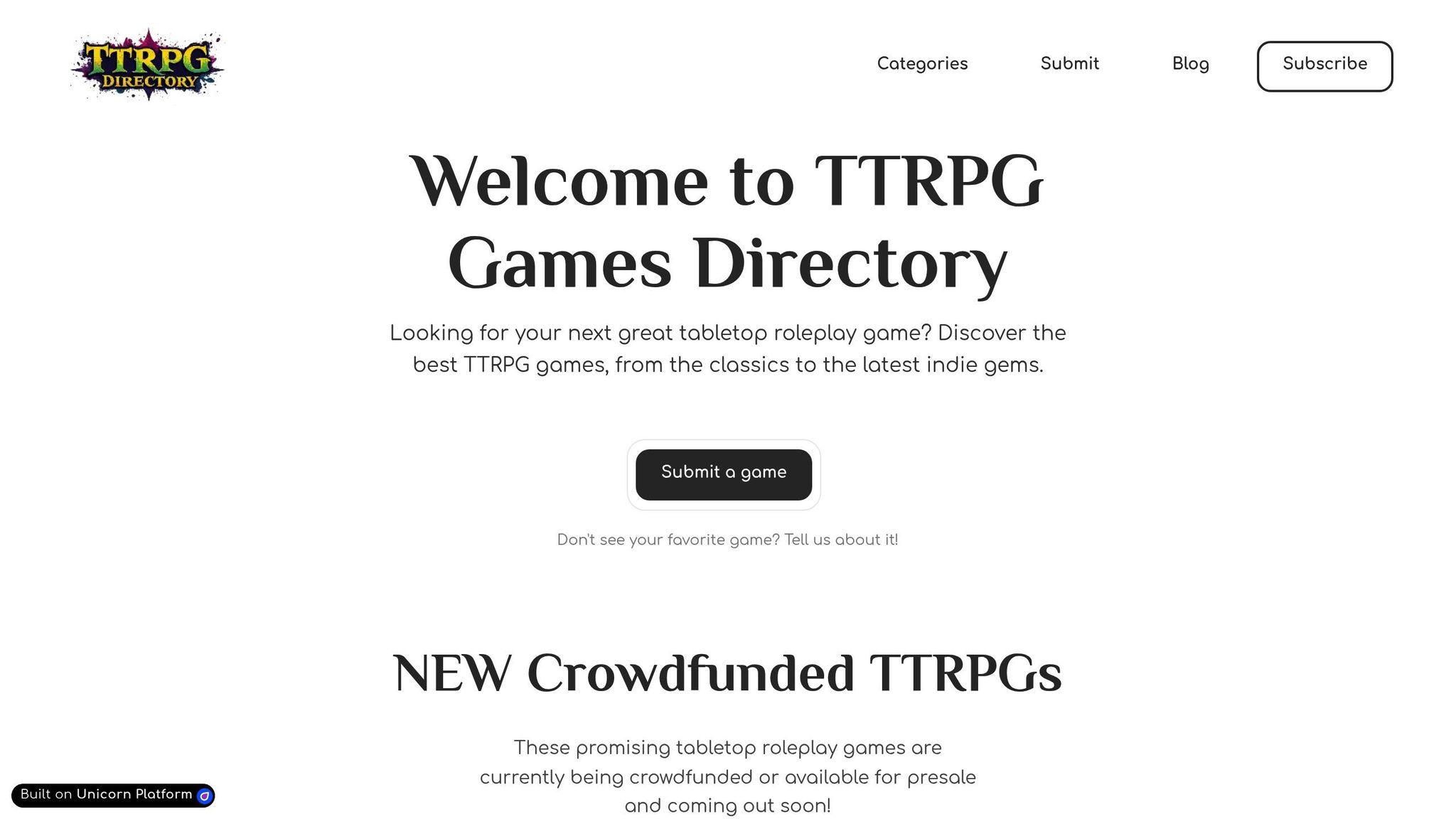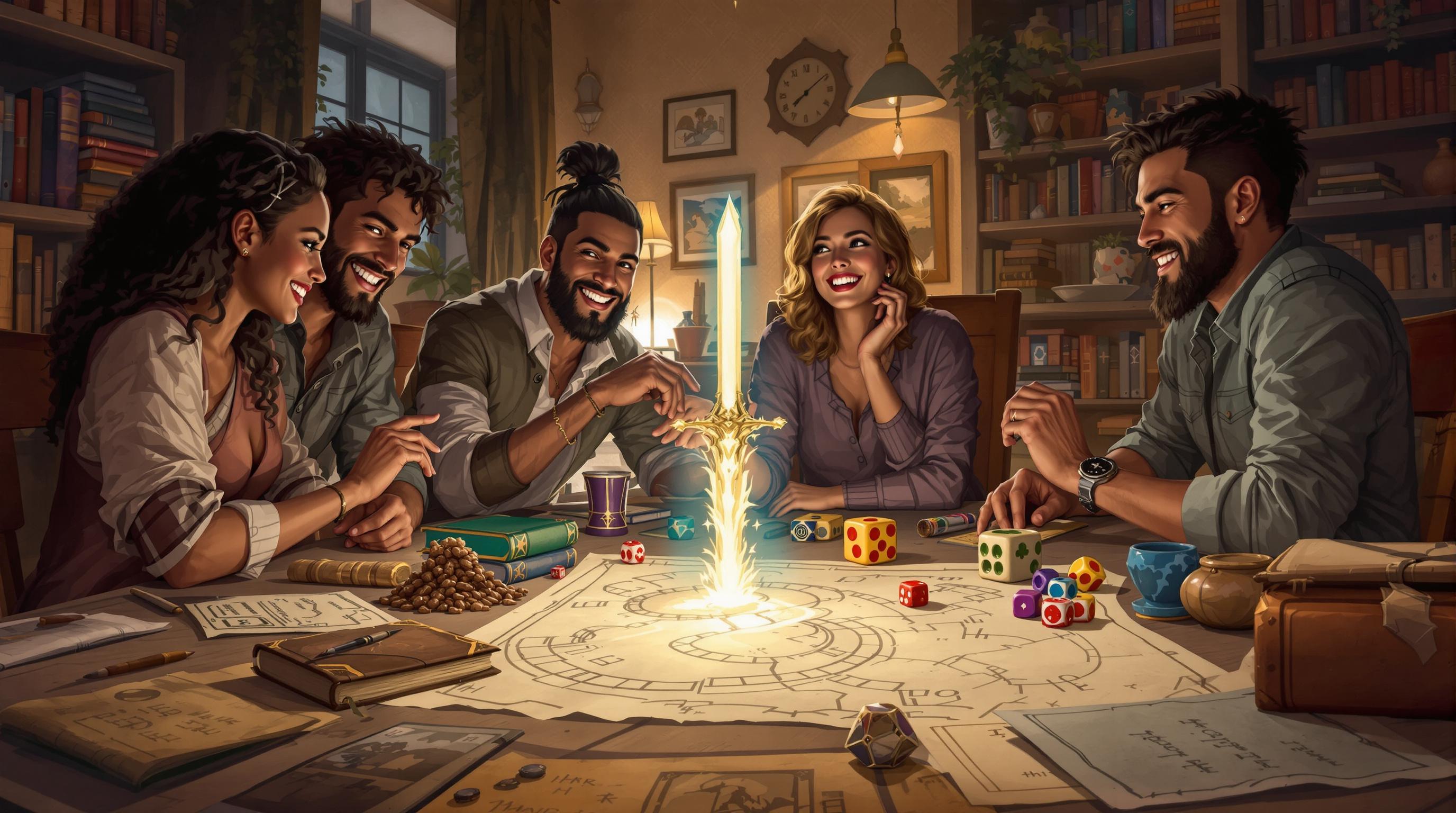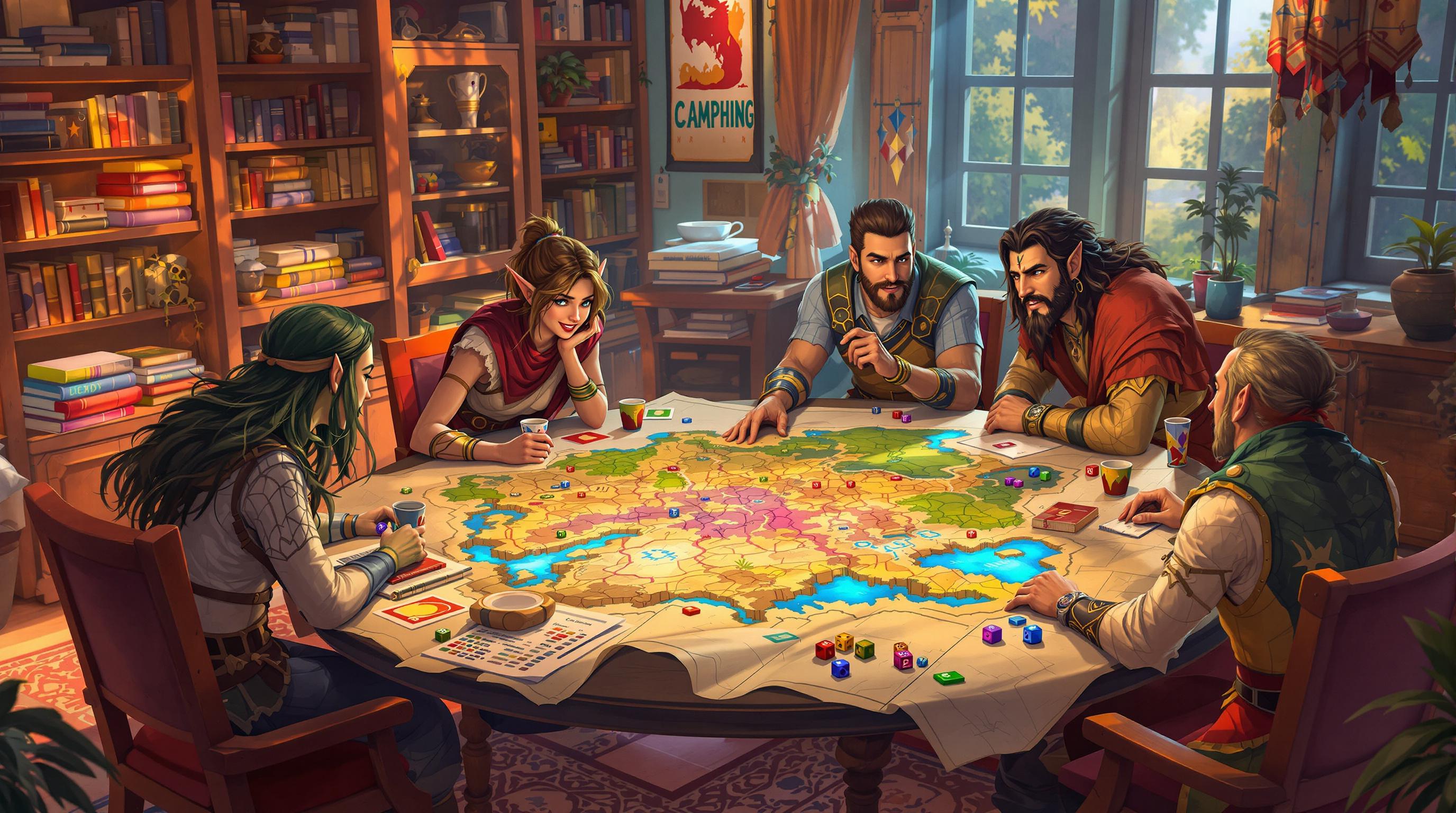Want to make your tabletop RPG sessions unforgettable? Add tension and scarcity. These two elements force players to make tough decisions, heighten emotional stakes, and create more engaging gameplay. Here's how:
- Tension: Build suspense by introducing high-stakes moments, time limits, or unpredictable outcomes. Let players feel the weight of their choices.
- Scarcity: Limit resources like gear, time, or abilities. This pushes players to prioritize and strategize, making every decision matter.
- Balance: Alternate between moments of pressure and relief to keep players engaged without overwhelming them.
Whether you're running a dungeon crawl, a space adventure, or a horror campaign, these methods can work in any setting. Keep reading for practical tips on resource management, storytelling techniques, and game mechanics that amplify tension and scarcity.
Run EPIC D&D Wilderness Survival/Exploration (Dungeons & Dragons | GM Tips)
Understanding Tension and Scarcity in TTRPGs
To truly appreciate how tension and scarcity shape tabletop role-playing games (TTRPGs), it's important to see how these elements influence the way players tackle challenges and make decisions. While they often work together, each brings its own kind of pressure, creating a more immersive and dynamic experience.
What Is Tension in TTRPGs?
Tension is that gripping emotional strain players feel when the stakes are high. As Ksenia Vasilyeva, Head of LiveOps Producing at Wargaming, puts it:
"Tension in game design is the magic thread that weaves through a story, turning a simple game into an epic adventure."
This feeling comes from unresolved questions, the fear of losing something valuable, or the uncertainty of what’s to come. It makes every choice feel significant.
Tension peaks during those critical moments when the outcome could swing dramatically. Every decision feels like it carries the weight of the world, a concept Eva Tucker, a video game producer and Women in Games Ambassador, highlights:
"Tension evokes emotion which has been proven time and time again to make people attached to a concept or story."
Take Shadows of Esteren, for example. Players start the game waking up in a pitch-black room, under attack, with no memory of who they are. This combination of mystery and immediate danger creates instant tension. But tension works best when it’s carefully paced:
"If everything is urgent, nothing is urgent."
If players are under constant stress, they can burn out. To keep them engaged, tension needs to ebb and flow, giving them moments to breathe before plunging back into high-stakes scenarios. These emotional highs and lows set the stage for scarcity, which adds another layer of complexity to the game.
How Scarcity Affects Gameplay
While tension raises emotional stakes, scarcity challenges players to think strategically. By limiting resources - whether it’s abilities, items, time, or options - scarcity forces players to prioritize and make tough choices. Instead of freely using their strongest abilities or hoarding supplies, they’re pushed to decide what’s truly necessary.
Scarcity doesn’t just affect resource management; it can also intensify the atmosphere. In horror-themed games, for instance, a limited supply of tools or weapons can heighten feelings of fear and vulnerability. This lack of resources makes players more cautious, drawing them deeper into the struggle for survival.
The real power of scarcity comes when it escalates alongside tension. Early in the game, resources might feel plentiful, making challenges more manageable. But as supplies dwindle and obstacles grow tougher, players must carefully weigh every decision. Balancing these moments of scarcity with occasional bursts of abundance makes the limited resources feel even more impactful.
Together, tension and scarcity create an unpredictable and engaging experience. John Woodworth sums it up perfectly:
"The rules are just there as a way to add random chance to the story, because if you already know how the story will turn out why play? Just read a book in that case."
When players face uncertainty and limitations, they’re not just following a script - they’re actively shaping the story, creating moments they’ll remember long after the game ends.
Methods for Building Resource Scarcity
Now that the impact of scarcity is clear, let’s dive into practical ways to introduce limits that create meaningful choices for players.
Adding Limited Resources
Scarcity can be introduced by managing available resources, making powerful abilities feel earned rather than routine.
Ease into resource limitations gradually. Bryan Cetroni from Bjarke the Bard highlights the importance of pacing when introducing resource scarcity:
"Resource drain will be best served gradually. Just as horror is best done in a growing fashion, so is the steady drain of resources. This steady increase makes the peak moments of your game much more noticeable."
Start your campaign with abundant resources and slowly tighten availability as the story progresses. This method gives players time to adjust without feeling overwhelmed.
Set expectations from the beginning. Cetroni advises being upfront about the challenges your campaign will introduce:
"Let your party know even before the campaign starts you aim to make encounters more difficult and give some broad examples. This will prepare your players for what your campaign will present."
By giving players a heads-up, you allow them to plan and embrace the challenges ahead.
Control loot distribution thoughtfully. Managing what magical items or equipment players find is a powerful way to maintain scarcity. Focus on limited-use items rather than permanent upgrades to keep tension alive.
You can also introduce specialized magic items that are only effective in specific scenarios. For example, a sword that deals extra damage to undead forces players to think strategically about when to use it, instead of breezing through every encounter.
Encourage meaningful resource decisions. The adventuring day model - where players face multiple encounters between long rests - works well here. It pushes players to decide when to use their most powerful abilities. But don’t limit this to combat. Include non-combat situations, like magical rituals, environmental challenges, or social encounters, that require players to spend resources like spell slots or special abilities.
Balance scarcity with moments of relief. While scarcity builds tension, players also need opportunities to recharge and feel powerful. As Cetroni warns:
"Also, try not to keep your party drained all the time. If the players rarely have time to refill the pools of their characters, it will feel like you are making a game that is out to punish the party."
Providing moments of abundance - like a chance to rest, resupply, or enjoy a heroic victory - makes the scarce periods feel more impactful by contrast.
Next, let’s explore how shared resource systems can add even more depth to group dynamics.
Using Token Systems and Shared Resource Pools
Shared resource systems go beyond individual management, encouraging teamwork and making every decision feel weighty.
Introduce visible token systems. Use tokens to track group resources or mounting tension. When players see tokens being removed from a shared pool or added to a tension track, it creates immediate awareness of the group’s situation and raises the stakes.
For example, Star Trek Adventures uses a Momentum system where the crew shares a metacurrency pool. Players can contribute to the pool with successful rolls, and anyone can spend from it to enhance their actions. This system naturally encourages collaboration, as individual success feeds into the group’s overall capability.
Mechanically track group tension. Games like Warhammer Fantasy Roleplay 3rd Edition incorporate a Party Sheet with a Tension track that increases during stressful moments. Adding tension tokens for prolonged decision-making or risky actions keeps players focused on the stakes.
Incorporate sacrifice-and-reward mechanics. Masks: A New Generation has a Team pool system where players can spend points to help allies or "burn" points for personal gain - boosting one stat while reducing another. This creates tough choices between aiding the group or advancing individual goals.
Use time as a shared resource. Token systems can represent time or mounting complications. For instance, each action might add tokens to an "Alert Level" or "Complication Pool." When the pool reaches a threshold, bad consequences affect the entire group. This makes every decision - like smashing down a door (loud and destructive) versus picking the lock (quieter but slower) - feel significant.
Keep the system visible and collaborative. Place tokens where all players can see and influence them. This transparency encourages discussion about resource use and helps players make informed decisions about when to take risks.
Storytelling Methods for Building Tension
While managing resources can create mechanical tension, storytelling techniques elevate ordinary encounters into gripping moments. A strong narrative ensures every decision feels impactful, keeping players deeply invested in the session.
Creating Obstacles and Time Limits
Introducing time constraints can push players into urgent decision-making. When they know the clock is ticking, every choice becomes more intense.
Timers force critical choices. As Jface Games puts it:
"One of the most effective ways to create tension in a tabletop RPG is through timers. A well-placed timer forces players to make tough choices, prioritize actions, and stay engaged in the scene."
Timers can take different forms:
- Passive timers move forward automatically, like a collapsing building in three rounds or a storm arriving in five minutes.
- Active timers require player actions to progress, such as unlocking a vault door over several rounds.
- Static timers have fixed deadlines, while variable timers add unpredictability, like rolling a die to determine when a ritual completes.
Layering timers adds complexity. For example, combining a bomb countdown with enemy reinforcements and a collapsing structure forces players to juggle priorities.
Balance clarity and mystery. Explicit timers let players plan, while hidden ones keep them guessing, creating a mix of strategy and suspense.
Respect player agency. Challenges should offer multiple solutions - whether players fight, sneak, or negotiate - each leading to logical consequences. Christian Amauger highlights the importance of this:
"Player agency is the heart of every thrilling adventure, the spark that lights the flame of immersion and engagement."
Set time limits that encourage action without stifling creativity. Provide enough information for informed decision-making, but keep the pace brisk to maintain tension.
By combining structured obstacles with time-sensitive challenges, you can create a narrative that keeps players hooked. But tension doesn't end there - random events play an equally important role in shaking up the story.
Adding Random Events and Consequences
Unexpected events can further disrupt plans and keep players on their toes. The element of surprise prevents gameplay from becoming predictable and forces players to adapt.
Introduce random events with purpose. Tie them to the main plot or side stories. As NullAshton advises:
"Try to always connect to them and view them in context of the main thread, or a side thread. If you can't do either, an idea is to record it as a 'Portent', to use in the future, and minimize the effect of the event."
Simple triggers, like dice rolls or in-game intervals, work well for introducing these surprises.
Break predictable patterns. Random events compel players to rethink their strategies. NullAshton explains:
"They disrupt your attention so that you pay attention to something else you may have missed that's still inside the plot."
Escalating tension tracks enhance suspense. These mechanics increase the likelihood of random complications as stakes rise, amplifying the atmosphere.
Keep outcomes logical. Random events should feel like natural consequences of player actions. For instance, a loud noise might attract guards, or lingering in a dangerous area could worsen conditions.
Prepare adaptable twists. Maintain a list of flexible complications, like a mysterious figure appearing or an environmental hazard emerging, to seamlessly integrate surprises into any scenario.
Tie events to character motivations. Personalizing random occurrences - such as a bandit recognizing a player from their past - adds emotional depth and raises the stakes.
By blending well-timed obstacles with unpredictable events, you create a dynamic and immersive experience. As Jface Games notes:
"Timers aren't just mechanical devices; they shape the emotional intensity of the session."
sbb-itb-b8b00a5
Game Mechanics That Create Scarcity and Tension
While storytelling sets the stage, game mechanics keep the tension alive throughout a campaign. Systems that focus on resource management force players to make tough decisions with limited options, creating natural moments of pressure. These mechanics work hand-in-hand with the narrative, ensuring that every choice feels meaningful and carries weight.
Examples of Scarcity-Based Game Mechanics
Stress tracks and condition systems gradually wear down characters over time. Unlike hit points that reset after every encounter, these systems accumulate lasting consequences. Players must weigh the risks of pushing forward with mounting stress against the need for recovery, knowing that either choice could lead to complications.
Limited-use abilities make every activation count. When players have only a handful of chances to use their most effective tools, they’re compelled to think strategically about when and how to deploy them.
Dice-based resource systems simplify the process of tracking while keeping the stakes high. As Rafael Romo Mulas explains:
"Complex math is great at making simulated worlds/people believable; but I agree with the general consensus: videogame mechanics don't translate well to tabletop, unless numbers are drastically reduced. And even then… In TTRPGs, any time used to count makes you lose immersion in the game!"
Abstract supply systems reduce bookkeeping by grouping resources into broader categories like supplies, ammunition, or energy. This approach maintains the feeling of scarcity without bogging players down with overly detailed tracking.
Milestone-based replenishment ties resource recovery to key story moments. Players regain abilities as they hit narrative milestones, creating a natural rhythm between tension and relief that aligns with the story's progression.
Environmental resource drains add constant pressure by introducing external challenges. Whether it’s harsh weather, toxic atmospheres, or magical effects that sap resources, these mechanics force players to balance exploration against survival.
The real power of resource management lies in its ability to amplify the excitement of other gameplay elements. As Yora puts it:
"I think what resource management can do is to make other parts of the game a lot more exciting and interesting."
Comparing Different Resource Management Systems
Here’s a closer look at how different resource management systems stack up, including their strengths and potential downsides:
| System Type | Complexity | Player Engagement | Best For | Potential Drawbacks |
|---|---|---|---|---|
| Detailed Tracking | High | Strategic planning | Simulation-focused games | Can slow gameplay and disrupt immersion |
| Abstract Counters | Low | Streamlined decisions | Story-driven campaigns | May feel less realistic |
| Dice-Based Resources | Medium | Tactile engagement | Games emphasizing risk | Requires physical components |
| Stress/Condition Tracks | Medium | Gradual tension building | Horror and survival genres | Can create death spirals |
| Milestone Recovery | Low | Story integration | Narrative-heavy campaigns | Reduces player control over pacing |
Each system offers a unique way to blend resource management with gameplay.
Detailed tracking systems cater to players who enjoy tactical depth, rewarding careful planning and optimization. However, they can slow the game if the bookkeeping becomes too cumbersome.
Abstract systems streamline the process by using general categories, ensuring smooth gameplay while still maintaining tension. They’re ideal for campaigns where story flow takes priority over granular realism.
Dice-based mechanics bring a tactile element to the table. Watching a dwindling supply of dice adds a physical, visual layer to the sense of scarcity, enhancing the feeling of risk and urgency.
Stress and condition systems shine in genres like horror and survival, where the gradual buildup of pressure adds to the atmosphere. But these systems need careful balancing to avoid creating scenarios where players feel trapped without options.
Milestone recovery ties resource management directly to the story, ensuring that players’ progress aligns with the narrative beats. However, it can limit players’ control over pacing, as recovery depends on reaching specific points in the story.
How TTRPG Games Directory Can Help You Find the Right System

If you're looking to dive into tabletop role-playing games (TTRPGs) that thrive on tension and scarcity, the TTRPG Games Directory is a game-changer. With thousands of systems to choose from, finding the right one can feel overwhelming. This directory simplifies the process by offering well-organized, categorized listings that highlight games designed with dynamic tension mechanics.
The directory provides detailed insights into each game, covering mechanics, themes, and standout features. Instead of spending endless hours researching on your own, you can quickly pinpoint systems that align with the gameplay experience you're after - especially those that emphasize stress, scarcity, and high-stakes decision-making.
One standout feature is its focus on stress-based systems. For instance, Blades in the Dark uses stress as a core mechanic. Players can absorb consequences by taking on stress, but too much leads to traumas, potentially forcing characters into retirement. This creates a constant push-and-pull where every choice feels meaningful.
Similarly, Legend of the Five Rings 5e introduces the Strife and Unmasking system, which captures emotional tension. Certain dice rolls generate Strife, and players can choose to Unmask, releasing pent-up emotions. While this can lead to dramatic moments, it also comes with both rewards and risks, adding depth to the narrative.
For fans of horror, Mothership ramps up the suspense with its Panic Checks. As stress builds, characters risk panicking, with outcomes ranging from adrenaline-fueled bursts of energy to debilitating heart attacks. This mechanic ensures that the atmosphere remains tense and unpredictable.
Other systems in the directory showcase even more creative approaches to tension mechanics. Cartel, built on the Powered by the Apocalypse framework, weaves stress into its narrative, where characters rely on dramatic vices to relieve tension. Meanwhile, Last Fleet and Flying Circus feature pressure systems that encourage players to push their limits. Raising pressure boosts rolls but can lead to critical breaking points when it maxes out.
For players who enjoy survival challenges, the directory highlights systems like Red Markets, which focuses on resource management in a post-apocalyptic economy, and Torchbearer, which tests players with hunger, exhaustion, and limited inventory during dungeon crawls.
The best part? The directory offers a free access tier, giving you an extensive look at game options without any cost. For Game Masters who want to rely on mechanics to create tension rather than solely on storytelling, this tool is a massive time-saver. It’s an efficient way to find the perfect system for your next campaign, whether you're aiming for nail-biting horror, emotional drama, or survival under pressure.
Conclusion: Adding Tension and Scarcity to Your TTRPG
Tension and scarcity are the finishing touches to creating truly immersive TTRPG sessions. When used effectively, they can transform a standard game night into a gripping adventure where every decision feels impactful. By combining resource management with storytelling techniques, you can strike the perfect balance between challenge and enjoyment.
As Rob Pardo, VP of Game Design at Blizzard Entertainment, put it:
"Players will often say they've had the most fun not in situations where the battle was perfectly balanced, but instead in games where they had a very slight advantage the entire time. That way, they were always winning, but the enemy put up enough of a fight that they felt scared".
This idea is directly tied to creating a dynamic experience in tabletop gaming. The trick is finding that sweet spot where players feel both the thrill of success and the tension of uncertainty.
Start by identifying the kind of tension you want to weave into your campaign. Maybe it's a sense of mystery through cryptic clues, time pressure from NPC actions, or the challenge of managing scarce resources. Each approach requires careful adjustment to fit your story and your players' preferences. These methods pair perfectly with the resource management strategies discussed earlier.
However, moderation is key. Overusing a single method can wear down its impact and lead to player fatigue. Mix things up - alternate between moments of abundance and scarcity, or give players a breather between intense encounters. The goal is to keep things fresh and make every choice matter by ensuring that different decisions lead to distinct, logical outcomes.
If you're looking for inspiration, the TTRPG Games Directory is a great resource. With its free access tier and detailed game descriptions, you can explore thousands of games that incorporate tension and scarcity mechanics, helping you find the perfect fit for your campaign.
Ease into these techniques by introducing one new idea at a time. Watch how your players react, adjust accordingly, and gradually build your arsenal of strategies. The best campaigns are born from understanding your players and tailoring the experience to their tastes.
Give these strategies a try in your next session - you might be surprised at how much more invested your players become in every choice they make.
FAQs
How can I add tension and scarcity to my TTRPG without making it too stressful for players?
To weave tension and scarcity into your game without overwhelming players, focus on crafting choices that matter. Introduce limited resources - like food, ammunition, or time - that players need to manage wisely. However, make sure they still have enough options to avoid feeling stuck or powerless.
Increase the tension gradually by raising the stakes over time instead of hitting players with everything at once. Tools like random event tables or storytelling prompts can add surprise elements that keep players on their toes and invested in the game. The key is balance - high-pressure moments should feel urgent but still within reach, ensuring players stay engaged and excited rather than frustrated.
What are some effective ways to introduce resource scarcity in a TTRPG campaign?
Resource scarcity can inject tension and complexity into any TTRPG campaign, pushing players to weigh their choices carefully. Here are some practical ways to incorporate it:
- Gradual depletion of resources: Introduce systems where vital supplies - like ammunition, food, or magical energy - slowly dwindle. This forces players to think critically about how and when to use what they have left.
- Survival-focused scenarios: Drop players into unforgiving environments where essentials like water, warmth, or medicine are hard to come by. The constant pressure of staying alive adds a layer of urgency and danger.
- Effort-driven mechanics: Implement rules where characters must spend limited resources, such as stamina or spell slots, to achieve their goals. This encourages players to plan their actions strategically.
These approaches can work across diverse campaign settings, from gritty post-apocalyptic landscapes to classic fantasy worlds, adding depth and keeping players on their toes.
How can I create a stronger sense of urgency and meaningful decisions in my TTRPG sessions?
To create a sense of urgency and inspire decisive actions in your TTRPG sessions, focus on designing scenarios where the stakes are high, and the consequences are immediate. Throw in unpredictable twists like random events or time-sensitive obstacles to keep players alert and deeply engaged in the story's outcome.
Use environmental storytelling to draw players into the world while subtly steering their decisions. Picture this: a rickety bridge on the verge of collapse or a flickering torch that threatens to leave the party in darkness. These elements not only heighten tension but also visually emphasize the need for quick thinking.
On top of that, make sure your players feel their choices matter. React to their actions in ways that are both meaningful and rewarding. By blending tension, immersion, and player agency, you’ll naturally encourage gameplay that’s not only more decisive but also far more captivating.


